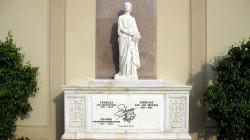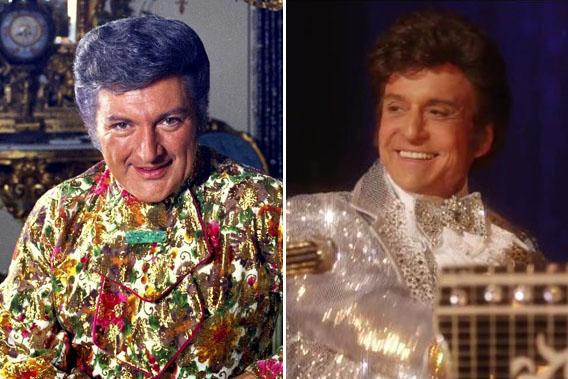Steven Soderbergh’s HBO movie Behind the Candelabra chronicles the turbulent five-year romance between famed concert pianist Liberace (played by Michael Douglas) and his young lover Scott Thorson (Matt Damon). Based on the 1988 memoir by Thorson, the film unveils the lavish lifestyle of the performer and the intimate circle of friends, lovers, and businessmen who surrounded him. This version of Liberace dons wigs, showers affection on Scott, and shows no shame about his sexuality—at least behind closed doors.
According to Douglas, Soderbergh first mentioned to him the idea of a Liberace project on the set of Traffic in 2000, and it wasn’t until a few years later that Thorson’s memoir gave him the proper entry point for the story. “I read the book and I thought, okay…I know how to get in,” Soderbergh has said. “It’s got a sort of finite period of time that we’re dealing with.” In fact, it appears that, despite the many several autobiographies and biographies that he could have drawn on—not to mention Thorson himself, who’s still living—the book really was the essential basis for Soderbergh’s story. “I did not talk to Scott before,” Damon said of preparing for the role. “I talked to Steven about whether I should and we decided it would be better not to. We got everything we needed from his book. I think meeting him before I did it, 30 years after this happened, wouldn’t have been helpful.”
How closely does Soderbergh hew to Thorson’s story of life with Liberace? Pretty closely—though the accuracy of Thorson’s book itself is another matter. (Thorson has served time for burglary in the past and was recently arrested again on similar charges.) Below, we’ve taken a look at a few key characters and events to see just how faithful the movie is to the book.
Scott Thorson
When the movie begins, Scott is working as an animal caretaker on a film set and living with his former foster parents, Joe and Rose. Later, Scott tells Liberace (whom he and others called Lee) that his mother has been “in and out of places” his whole life, though it’s never explicitly stated that she was a manic-depressive, as he explains in his memoir. We don’t see any of his siblings, some of whom are featured in the book, but Scott does mention his two sisters, brother, and four half siblings. He also matter-of-factly mentions to Lee that he is bisexual, which Thorson also recounts frankly in his book. “After a couple of fumbling, adolescent sexual encounters with girls while living on the ranch,” he writes, “I admitted feeling equally attracted to men.”
Liberace’s Childhood
According to Thorson, Liberace’s mother Frances (Debbie Reynolds) pushed him hard to practice the piano as a child, forsaking playtime with other kids—and the film presents a similar story. These accounts differ, though, from Darden Asbury Pyron’s 2000 biography, Liberace: An American Boy, which suggests that as a child, the future star was more than happy to practice on his own (“His parents could not tear him away from the upright in his parlor”) and didn’t seem to mind not having friends.

Photo by Claudette Barius/HBO
How They Met
Thorson’s friend Bob Black (Scott Bakula), a choreographer-dancer, invited Thorson to see Liberace’s show during a trip to Las Vegas, which led to their meeting backstage afterwards, as the film depicts. Liberace has a protégé at the time called “Jerry O’Rourke” in the book; in the movie, his name is changed to Billy Leatherwood (Cheyenne Jackson). Like his real-life counterpart, Billy is immediately unhappy about Scott’s arrival. Billy/Jerry is married—after seeing him play in a piano bar, Liberace offers him a performing contract with the caveat that he leave behind his wife and kids, according to the memoir—and by the time Thorson is in the picture, his relationship with Liberace is already on the rocks. In Soderbergh’s account, he moves out of Liberace’s mansion the day Thorson arrives; the memoir says that that Jerry stayed, despite everyone’s discomfort, for four more months.
Plastic Surgery and Adoption
As recounted by Thorson and echoed by Soderbergh’s movie, Liberace was saddened that he had never had children, and attempted to mold Scott into the son he never had. He even insisted that the then-20-year-old Thorson get plastic surgery to look more like him, and to slim down using a pill concoction known as the “California Diet.” (Thorson cites this diet as the beginning of his descent into drug addiction.) The surgery was a success; many people commented on how much Thorson looked like Liberace’s son, which apparently “thrilled” the performer. Talk soon turned to Liberace legally adopting Scott. “I wanted to be loved, to be cared for, and to give all those things in return. To belong,” Thorson writes. Yet while the two consulted with a lawyer, the adoption never came to pass, as the film notes near the end, when we see Scott questioned by Liberace’s lawyers. (For that scene, Soderbergh seems to have culled from another source other than Thorson’s book: The transcript of the deposition in the case of Thorson v. Liberace.)
The Confrontation
After discovering that Liberace had cheated on him, a furious Thorson left the Vegas mansion for the penthouse Lee bought for him. In his memoir, Thorson says this led immediately to his eviction, that Seymour Heller (Dan Aykroyd), Lee’s agent and manager, plotted to “remove [him] from Lee’s life—permanently” while he slept that night. He is soon confronted by a private investigator and a few assistants, who attempt to get him to leave and suggest he go to a hospital to seek addiction treatment. Thorson doesn’t cooperate until realizing he has no other choice. As in the book, he agrees to leave the penthouse and come back to get his things later, after Lee has left for the 54th Academy Awards.
The Lawsuit
Thorson gives a detailed retelling of the lawsuit he filed against Liberace, while Soderbergh condenses the years-long legal battles to a few short scenes. A title card jumps to the year 1984, and then we see Thorson and his lawyer Felder (Paul Reiser) discussing possessions and legal documents with Lee’s lawyers. Felder tells Thorson that he’ll get $75,000 in cash, three cars, three dogs, and all of his clothes if—and only if—he signs over the title of his house, all of its contents, and three specified cars.* This is recounted exactly in Thorson’s book, though, according to him, the agreement was settled on in 1982, before he officially filed a lawsuit. Thorson reluctantly agreed to sign it because he was “desperate for money” at the time.
The Reconciliation
According to Thorson, Liberace called him in early 1986, while their legal battles were still raging, to find out if he was “feeling all right.” While it was never referred to directly, Thorson believed that Lee wanted to make sure he hadn’t contracted the AIDS virus, as there were rumors that he had. The movie re-creates this scene, as well as Scott’s final meeting with Liberace at his home, where he lay dying. Soderbergh takes lines directly from Behind the Candelabra here, including Liberace’s sad comment, “I don’t want to be remembered as some old queen who died of AIDS.”
The Autopsy
As recounted in the Thorson’s book and elsewhere, Liberace’s cause of death was first described as cardiac arrest caused by cardiac failure, but the death certificate was rejected by the County Health Department. Heller (and Liberace’s lawyers) maintained that he died of heart failure, but because California law required that all suspicions of contagious diseases be reported to the coroner’s office, an autopsy was performed. After taking tissue samples from his embalmed body, Liberace’s death by AIDs was confirmed.

Kafziel/Wikipedia
The Funeral
By Thorson’s account, the day of Lee’s funeral was a beautiful one, though the ceremony itself was rather “drab,” unfit for someone who lived as lavishly as Liberace. The final scene in Soderbergh’s adaptation brings to life the funeral Thorson felt his former love would have appreciated: a Rolls Royce, “a sarcophagus draped in his favorite fur,” and Thorson himself in a fox cape with a 16-foot train. It’s a fitting—and accurate—tribute to Liberace’s memory.
Previously
How Faithful Is The Great Gatsby?
How True Is Pain & Gain?
How Accurate Is Lincoln?
How Accurate Is Argo?
Who Are the People in Zero Dark Thirty?
How Much Scientology Made It into The Master?
* Correction, 3:21 p.m.: This post originally said that Liberace would receive the $75,000, the three cars, and the three dogs.
